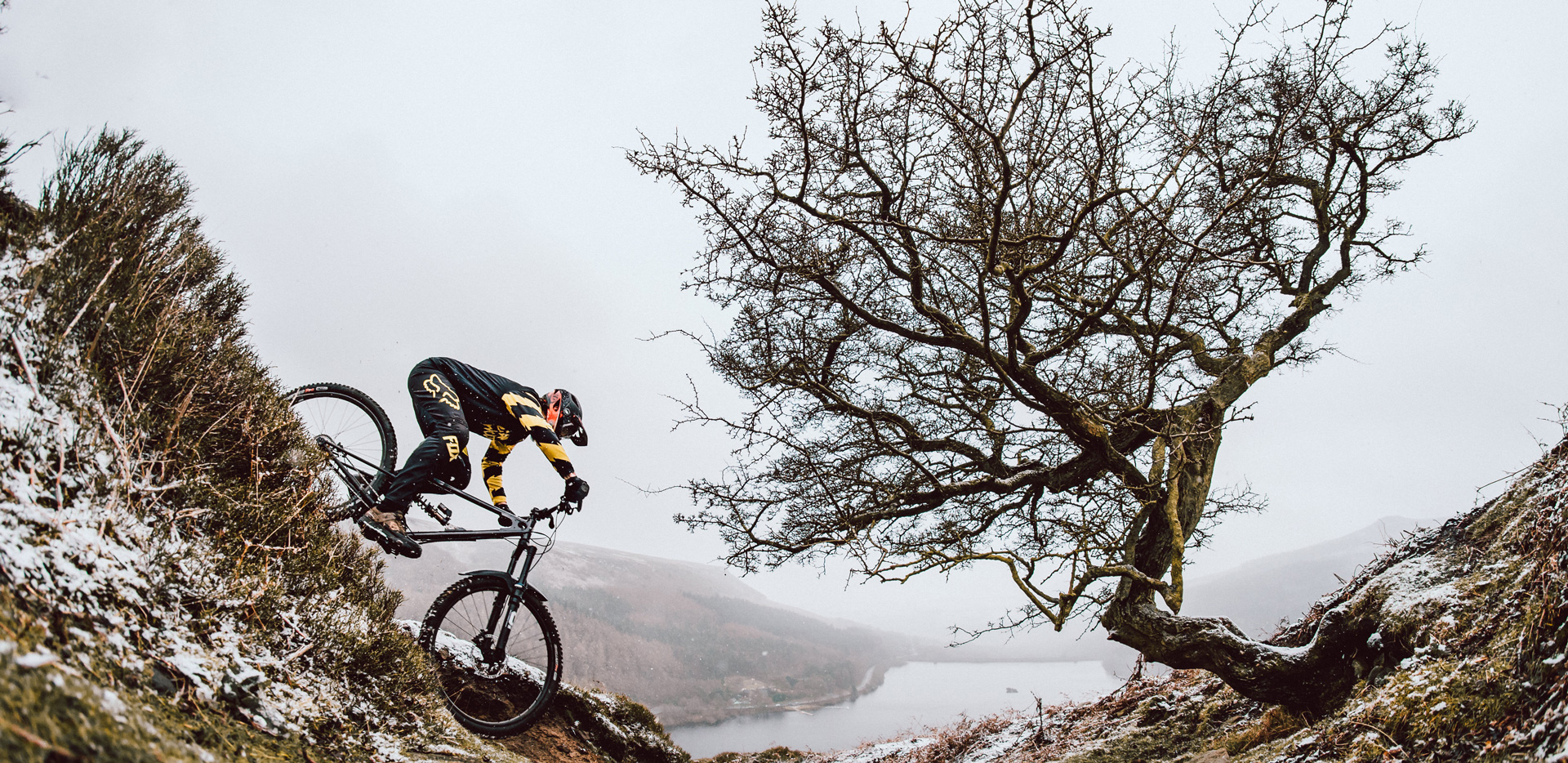
STARLING CYCLES SPUR GEARBOX PROTOTYPE REVIEW
THE FUTURE OF SELF-POWERED BIKES?
Words by Robert Johnston
Photos by Adam Lievesley
Never content on sitting back and letting his bikes sell themselves, Joe McEwan of Starling Cycles is constantly looking to find performance gains through prototyping interesting machines, like the High Jack Pivot Staer we tested back in 2019. The conception of the Staer came about as an accident of sorts, as the mis-machining of some frame components for a gearbox prototype left Starling with some expensive steel bits laying around. This was rectified the next time round, and so the Starling Spur gearbox prototype was born. I just had to get some time on it, so I was thankful that Joe was keen to let me put it to work for a couple months to produce this feature.
THE LAB
The Starling Spur is Joe’s take on the ultimate enduro bike, with 170mm travel at both ends, modern enduro-ready geometry; and of course, a different approach to gear shifting than a conventional bike. At its heart is the striking machined casing of the Effigear gearbox, which sits neatly within the signature Starling steel frame tubing thanks to some custom machined steel plates.
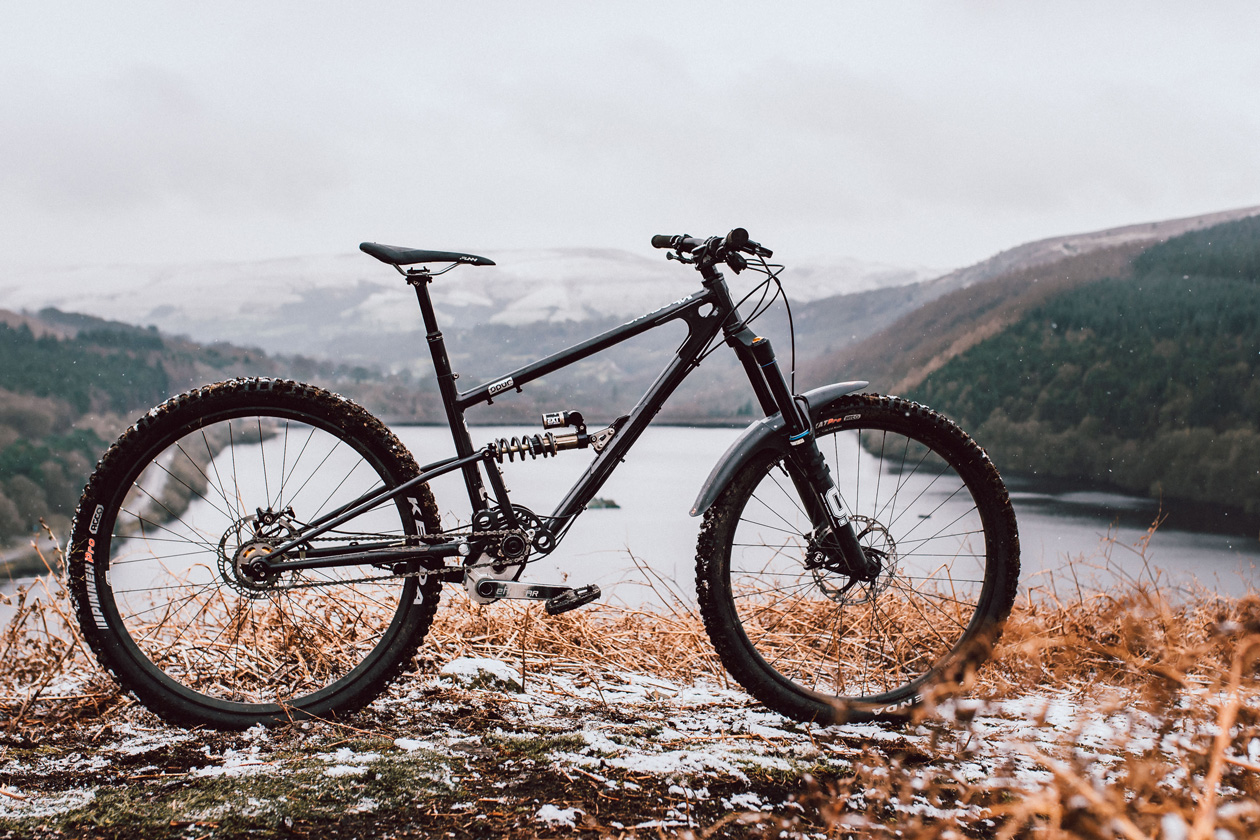
The Effigear gearbox sees the shifting duties relocated to within the front triangle of the frame, where there is a series of cogs within the gearbox housing. This housing contains an oil bath, like the typical gearbox on your car, giving the cogs the necessary lubrication to allow them to run for thousands of miles without a need to go inside. A single cog within the gearbox sits on the input shaft to which the cranks are mounted and drives a second cluster of cogs on the secondary shaft. These cogs are constantly meshed to their counterparts on the third (output) shaft, and each forms a distinct gear ratio based on the ratio between their teeth. The shifter selects the cog on the secondary shaft that is to be engaged, whilst the remainder are free to spin. The engaged cog then transfers the power to its mating cog on the output shaft, which drives the cog on the outside of the gearbox and transmits the force through the chain and into the rear wheel. Simple, right? As hard it is to describe concisely, the operation of the gearbox is based on time-served technologies from the automotive world, so you can rest assured it will stand up to the abuse of a mountain bike over time.
What does the gearbox seek to achieve? Well, the most obvious difference between this bike and a ‘conventional’ bike is the lack of a rear derailleur and cassette on the back wheel. This should provide numerous benefits out on the trail. Firstly, ripping off derailleurs or bending hangers is a thing of the past, as they simply do not exist. Combining this with a narrower rear hub (due to less width taken up by the singular rear cog vs a cassette) affords a narrower rear end, letting the bike squeeze through tighter ruts and gaps in the trail without issue. This lack of derailleur and extra cogs leads to a significant saving of weight on the rear wheel, which should allow the wheel to move out of the way of obstacles easier due to its lower inertia. The weight of these cogs and derailleur (plus a bit extra due to extra shafts, the oil bath, and the need to create a structural shell to contain it all that is damage resilient enough for typical mountain bike abuse), is then contained low and centrally in the frame, sitting around the area that the front chainring would usually occupy. This alters the sprung:unsprung mass ratio considerably in the positive direction (higher sprung, lower unsprung). If you have ridden an eMTB you may already be aware of the benefit of this altered ratio, which yields improved chassis stability and a more reactive feeling rear end. All of these should add up to improved suspension performance, letting the wheel track the ground better and ultimately increasing the amount of grip available.
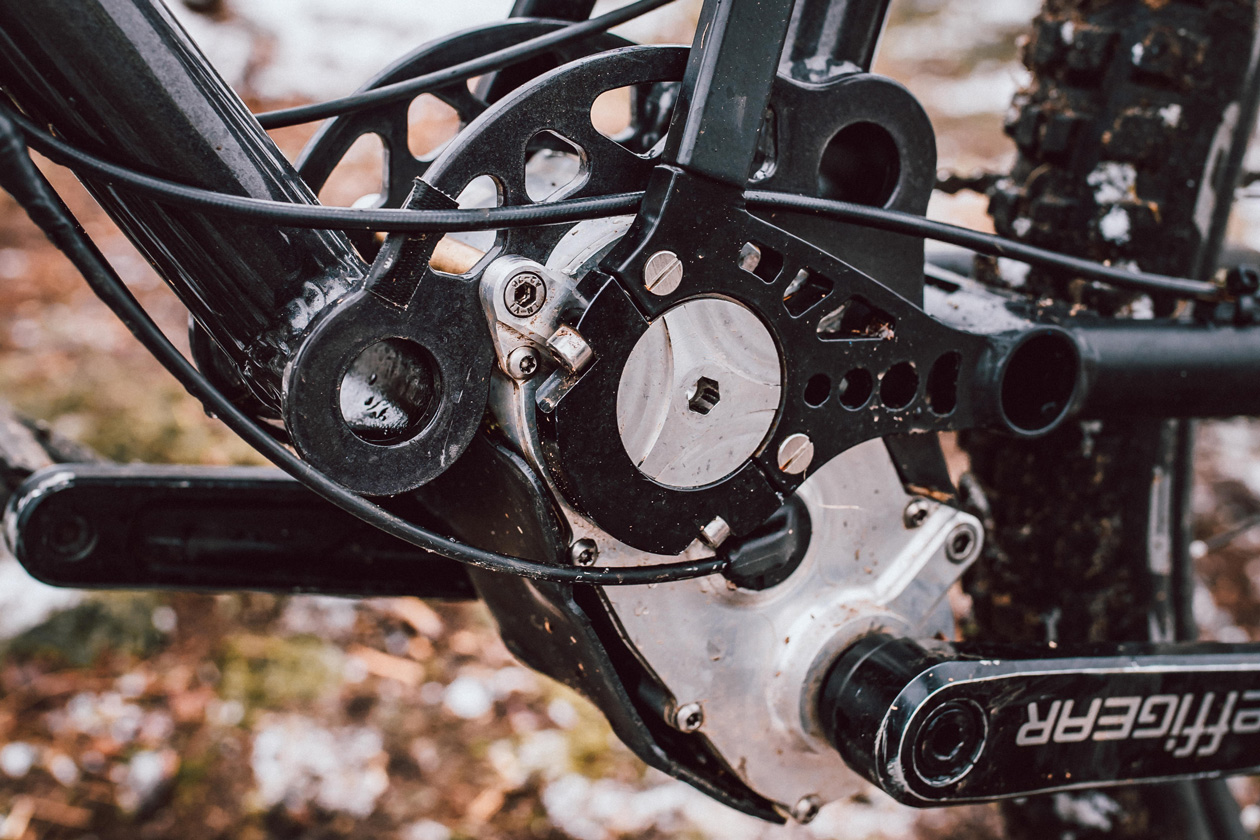
Shifting the Effigear gearbox is more “natural” than the likes of the gearbox competitor Pinion, thanks to its standard trigger shifter on the bar instead of relying on a grip-shift. This is made possible thanks to a spring-tensioned cable, which pulls the cable taught from the opposite side of the gearbox selector shaft than the shift cable inlet. The unit fitted to the Spur on test was a 6-speed unit with a large spread of gears that was equivalent to a 12spd setup, but of course with large gaps between each ratio. This 6spd gearbox was an experiment by Starling to determine if there was any drag to be saved, but production models will ship with the equally efficient 9spd unit instead. Shifting to a harder gear is as simple as hitting the shifter, with no let-off of power required. Shifting to an easier ratio requires a slight technique adjustment however, with the need to let off the power entirely to allow the gear to pop into place. After hitting the downshift paddle, you can continue to pedal to your heart’s content, but will only receive the easier ratio once you perform the necessary let-off. When coasting, shifting either direction requires no pedaling input, which allows for useful pre-emptive shifting.
With the Effigear’s output cog designed to sit concentrically to the suspension pivot, the chain does not see any growth throughout the travel, negating the need for any form of sprung tensioner. Starling’s solution to chain tension comes in the form of an eccentric dropout, which allows the distance between the output cog and rear axle to be altered with just an Allen key. This comes with an additional benefit of an adjustable geometry – the wheel will usually have two positions that create the same effective chain length, producing a “high” and “low” setting for the bb with a slight effect on the head angle and seat angle also. The choice of hardcore Winter riders, single speed drivetrain setups are considerably easier to maintain; last longer due to a constantly straight chainline without shifting causing side-forces on the chain links; and potentially even stay cleaner due to the extra ground clearance of the chain compared with a dangling derailleur. This aligns well with Starling’s long-running mantra of reducing time spent in the garage performing maintenance in order to maximize time out on the trails.
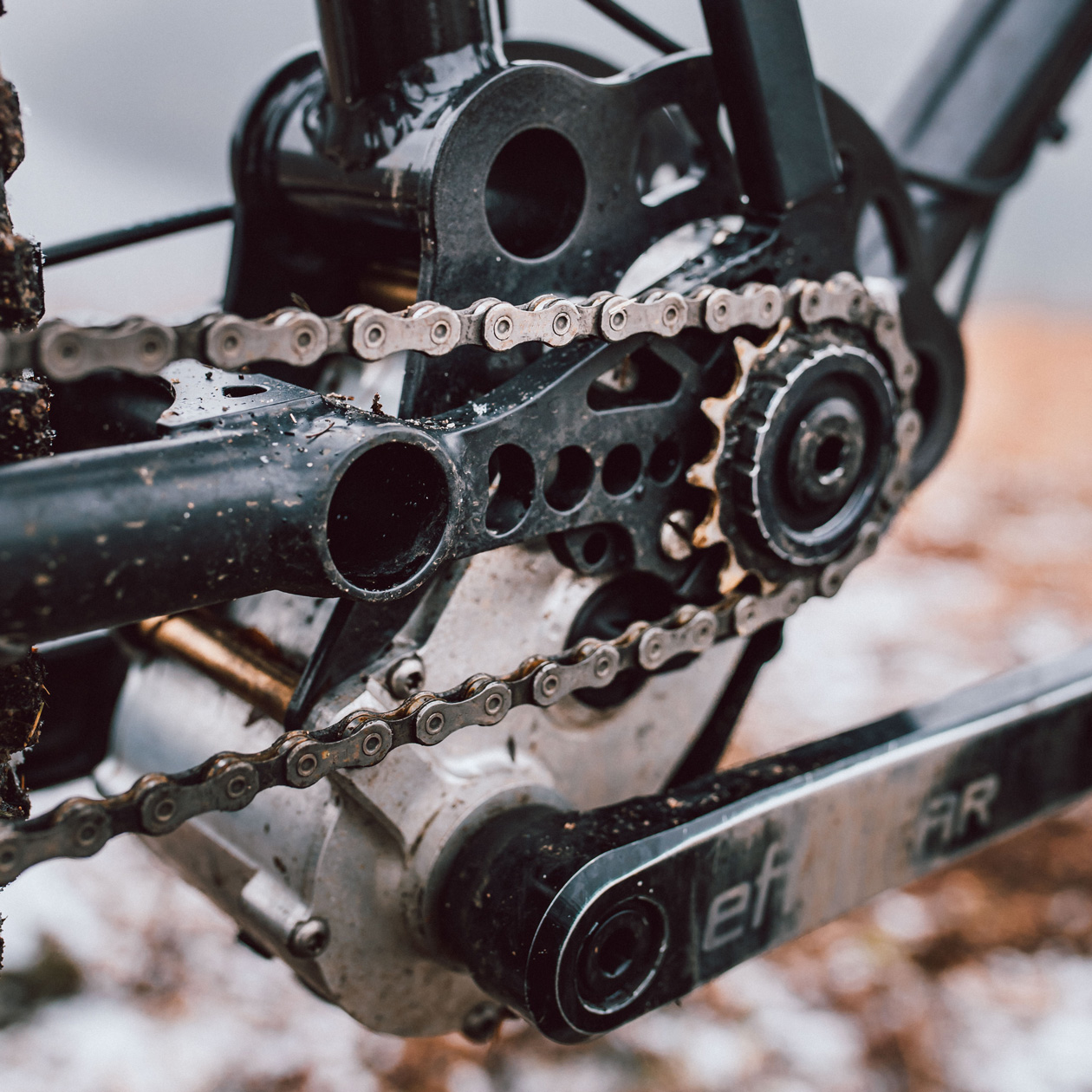
The orientation of the Effigear box has a direct effect on the suspension pivot locations and subsequent characteristics of the rear end. With Joe’s selected position, the single pivot rear end sits slightly below and forward of where a regular chainring would sit. This leads to a long effective lever around which the wheel pivots, which produces a relatively straight and primarily vertical axle path. As the front cog and suspension pivot sit concentrically, and there is only a single rear cog, the pedaling characteristics remain constant regardless of the gear selected. Modifying the size of the two external cogs allows for some tuning of this, with a larger rear cog or smaller front cog offering increased pedaling support but reducing the gear ratios and potentially causing issues with spin-out in the hardest gear. The supplied 15t front cog paired with a 25t rear cog produces low anti-squat values, creating a bike with limited pedaling support but an accompanying high level of grip when pedaling. Thankfully, the Spur’s EXT Storia LOK V3 shock features an easily accessible climb switch, firming up the rear end to make the less technical climbs more pleasant.

As with the Staer tested previously, geometry of this Spur prototype was in keeping with the times, without going extreme. A 64-degree head angle, 73.8-degree effective seat angle, 475mm reach and 450mm stays combine to produce a stable package that matches the intentions of the gearbox-equipped 170mm travel bruiser. There is a sliding mount on the front end of the shock, which would allow for some geometry adjustment, but this was left in its standard setting throughout the test as the gearbox was the primary focus. The production Spur will feature a steeper 77-degree seat tube angle and slightly longer reach number, bringing the numbers in line with the 2021 expectations for a bike of this kind. Cable routing is the mechanic-friendly external setup, save for the last section of the dropper cable entering the bottom of the seat tube. With the gearbox there is no mech hanger nor bottom bracket to worry about, and the rear brake mount relies on an IS mount setup that requires the appropriate adaptor for the rotor size you desire. A slide-in bottle such as the Fabric or Fidlock system will squeeze into the underside of the top tube above the shock for the hydration lovers.
The supplied build was no-nonsense, with coil sprung suspension on both ends thanks to the Öhlins RXF 36 fork paired with the aforementioned EXT Storia LOK V3 rear shock. Magura MT Trail brakes with a 203mm front and 180mm rear rotor (due to availability) were tasked with stopping duties. A custom Project 321 single speed rear hub laced to a Mavic XM481 rim handled the abuse out back, with a Hunt Endurowide front wheel called upon. Relatively burly Kenda tires were fitted due to my familiarity and trust in them, with the ATC casing Hellkat on the front paired with the sturdy AGC Pinner with a Rimpact insert in the rear to ensure the hard charging would be supported. A Funn 35mm cockpit and saddle and Bikeyoke revive dropper rounded out the build, totaling up to a weight of 40.8lbs (18.5kg). Not a light bike, then, but there’s certainly room to shave off a good bit of weight for those so inclined. The tire setup alone could stand to lose up to a kilo, with Joe suggesting the suspension performance can negate the need to run such a burly tire setup.
Starling hopes to open the books for orders on the Spur from late summer and expects the retail to be in the region of £3k+ for frame with gearbox.
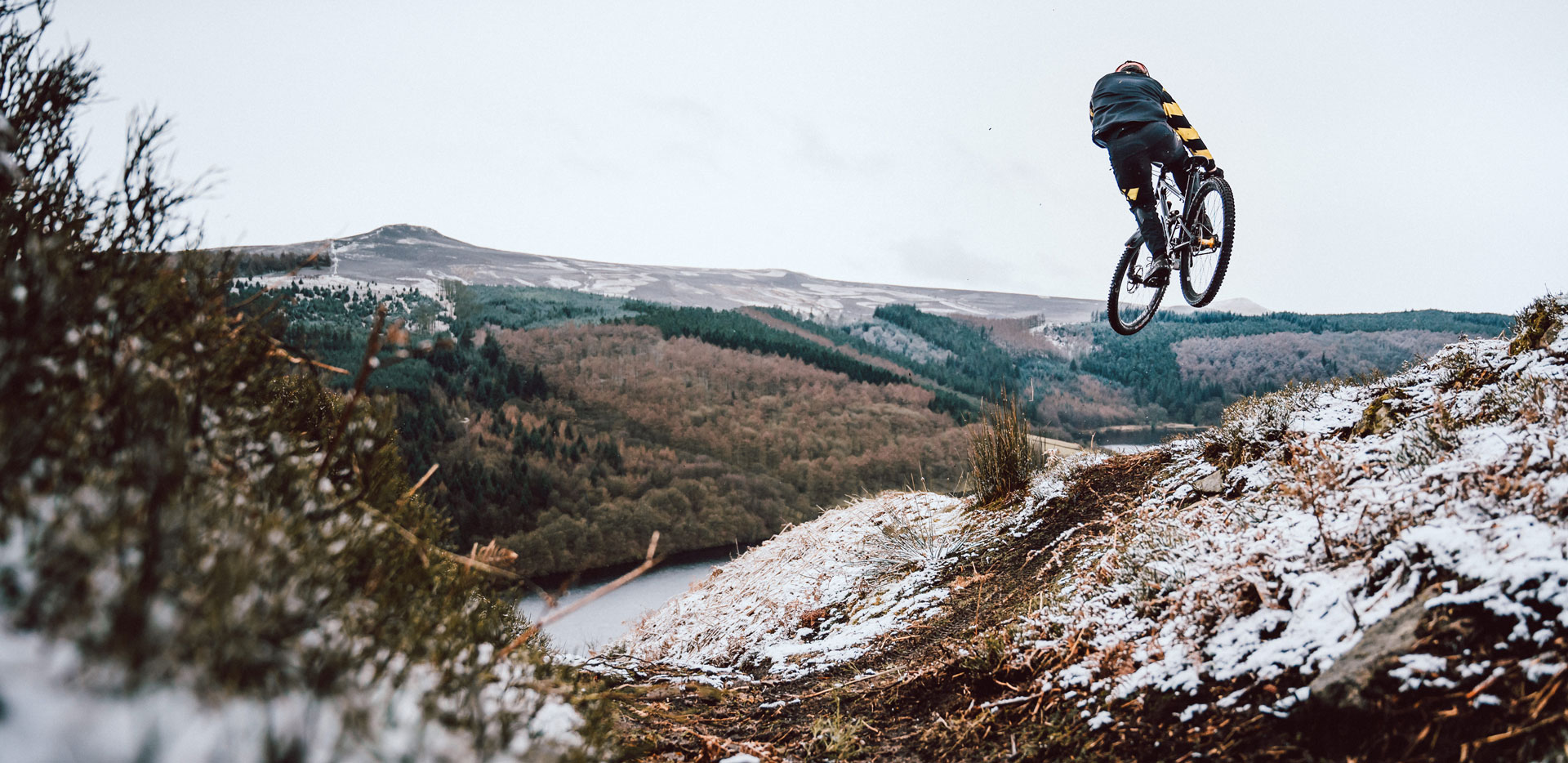
THE DIRT
Thanks to the trigger shifter setup, hopping onto the Effigear-equipped Starling Spur required less adjustment to my usual riding style than I had expected. Shifting to a harder gear is phenomenal, with the shift happening inside the box before your thumb has even let off the shifter paddle. It is so quick and solid in fact that it becomes addictive, with the feeling of the sudden increase in ratio when on the gas much like a sequential gearbox in a rally car, or at least how I would imagine they feel. You can change to an easier gear at the shifter any time, but until you let off the power the shift will not take place inside the box. This did not prove to be much of a problem once you came to expect it, as you could make the shift and continue to concentrate on pedaling until a convenient time to let off presented itself. I tended to go a step further than just letting off, by quarter-cranking back ready to give it maximum power once the gear changed. Throughout the test the gear shifting never skipped a beat, with full trust that things would be in place ready to lay down power at any moment. Coasting down the trail, the ability to pre-emptively shift either direction of the box and have the newly selected gear ready to go becomes a very useful tool to have at your disposal. This was especially useful on the approach to a short pinch of climb, where you could leave derailleur-equipped buddies in your dust as they delicately crunch through half of their cassette. This benefit also presents itself at the top of a trail, where there is no need to mess about spinning the cranks to change gear before dropping in, simply shift and go.
The question that is on the minds of many: how bad is the drag? Unfortunately, I was not able to run any tests with data capturing involved, so you’ll have to settle for my perceptions for now. What I have always read about gearbox bikes is their consistency throughout conditions, with them closing the efficiency gap on derailleur setups when conditions get extra muddy. This seemed to run true in the case of the Spur, who is testing fell in the bleak UK winter when trail conditions were decidedly gloopy. Throughout these gloopy rides, there was next to no perceivable change in the running friction of the system, the chain remained considerably cleaner than my derailleur-running compadres, and the shifting remained entirely unaffected. When things did eventually dry out, the drag in the system did become apparent. You do not tend to feel the drag on technical climbs, with low cadence muscling feeling quite normal and particularly solid underfoot. It is the longer drags of constant-gradient climb that really hold the Spur’s Effigear drivetrain back, with the slight mechanical “buzz” making it apparent that you are not on a conventional drivetrain, and the definite feeling of some energy being sapped out of each revolution of the crank. Exactly how much would require some data to be accurate. I have seen a number of 2-4% stated by Effigear in the past, which sounds plausible. There is no doubt that it is there, but it is far from ridiculous. The apparent strength of my legs varies more from ride to ride than that. Whether it is a cause for concern or irrelevant will depend on the terrain you ride, as some rides it made next to no effect.
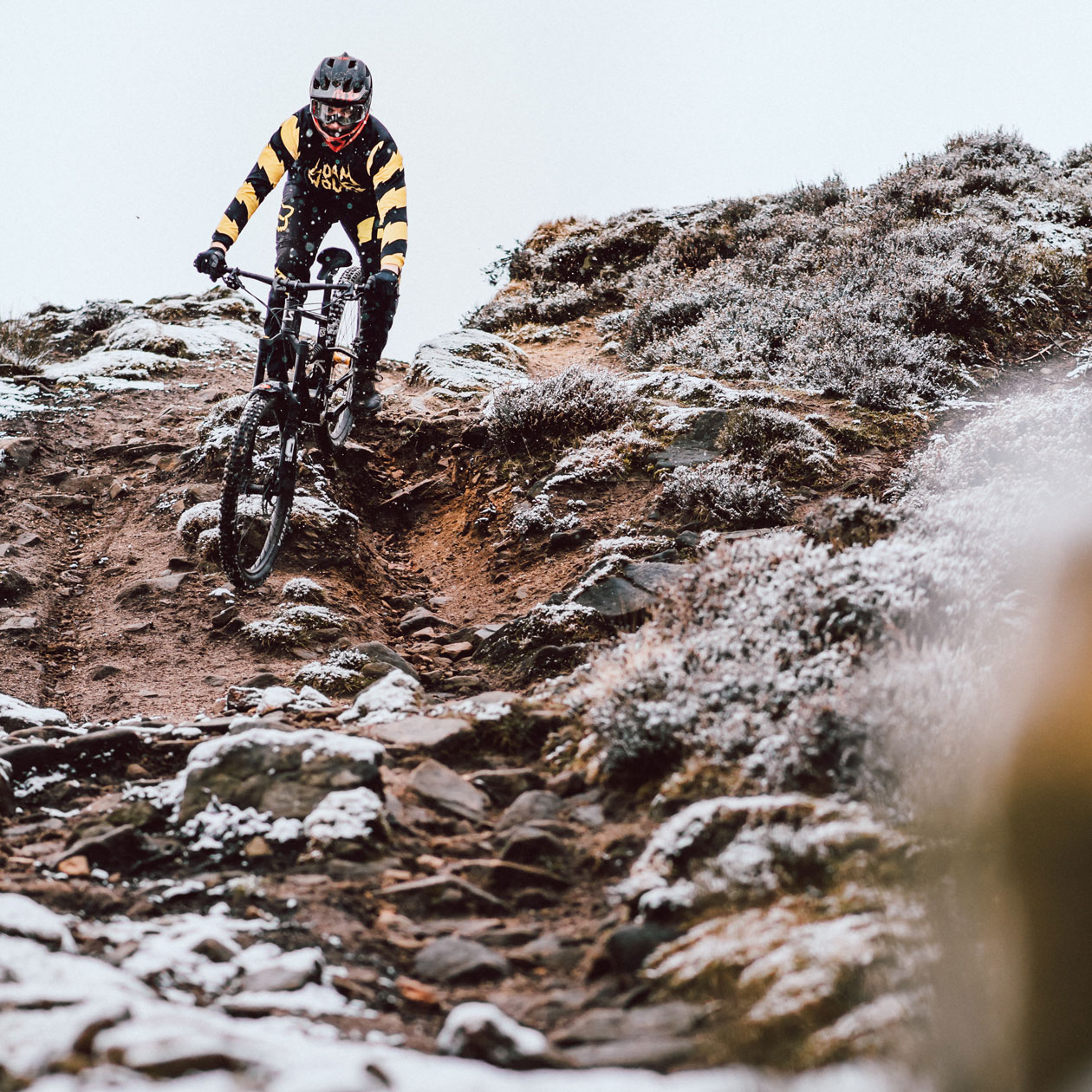
There is no mistaking that the Spur is a long and slack coil sprung bike, but you would be silly for expecting anything else. The climbing position was comfortable with the saddle slammed forward on the rails (which the production model’s steeper 77-degree seat tube angle will improve upon), giving a solid base from which to spin the legs. The 6spd gearbox quickly showed its downsides on the climbs where cadence is important, with the steps between gears making it feel as if you are never in the right gear for the situation. This led to some suffering trying to push a hard gear, followed by a disruptive downshift into an overly easy gear. Maybe my legs have just become soft with the widespread use of 12spd setups, but it was a real crux in the abilities of the Spur under my power. The 9spd box on the production models will go some ways to solving this, though I do still wonder if some may still find the gear steps a little larger than ideal.
With the low anti-squat figures built into the system, pedaling support was minimal and led to a lot of pedal bob when the shock was left open. A quick flick of the EXT shocks LOK lever improved things considerably, but the platform was still not as firm as many. This contributes to the overall difficulty in pedaling the Spur on smooth terrain. However, the flipside of this is the phenomenal ability to claw its way up technical terrain. Spin the legs and keep the Spur pointed in the right direction up a rough or slick piece of climb and it is incredible what it will get up. It is not one to pick its way delicately and gracefully through a technical climb section, favoring the point, shoot, and hold on for dear life method. In these situations, the lack of a rear derailleur and the slightly increased ground clearance thanks to the lack of front chainring comes into its own, letting you get away with lines that a regular bike just cannot hack.
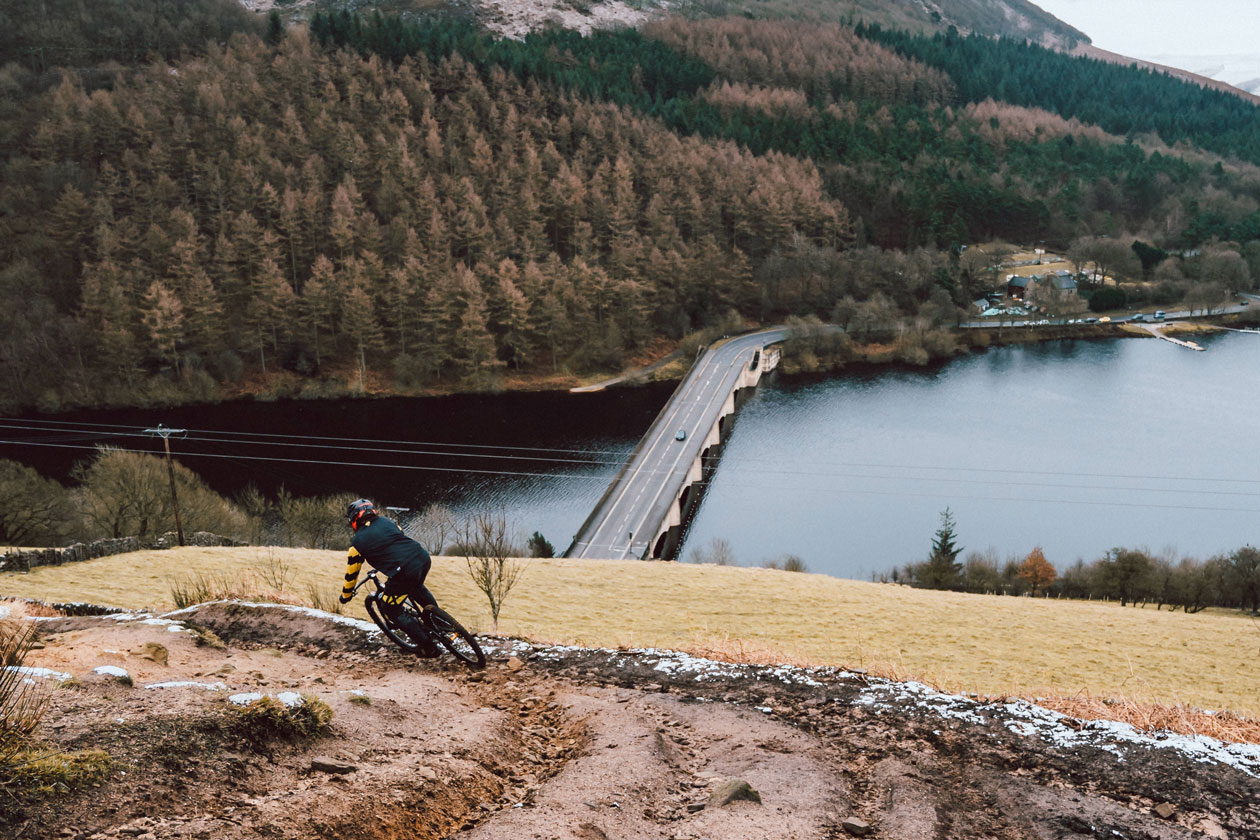
This point and shoot mentality carry on to the descents onboard the Spur and is really the most special trait of them all. The ability to aim at a rocky, near unrideable line, dip the heels and plough through is incredible, with the rear wheel skipping through effortlessly. The combination of the quiet rear hub and lack of any chain slap or rattle leads to an eerily quiet bike, with the beautiful soundtrack of tires on dirt and dampers whooshing. Although most of the test was spent with a full-on downhill tire in the rear to prevent sidewall slices from putting a damper on my days onboard the Spur, it is easy to understand why Joe would suggest you can run a lighter casing tire, especially with an insert fitted. The lack of feedback through the pedals in this rough terrain was seriously impressive and adds to the confidence inspired by the stable geometry. Much like an e-MTB, the feeling of the weight concentrated between your feet adds an extra level of stability, with the chassis less affected by trail obstacles and the wheels and suspension instead doing more of the work. The wheel’s ability to react to the terrain and stay stuck to the ground leads to a very encouraging level of grip on the back end, allowing for later braking and fewer “oh s**t” moments through root and rock infested descents. Hard braking efforts on the Spur are relatively composed, with a slight firming of the rear end but nothing drastic. The same benefits of the removed derailleur and increased ground clearance are present on the descents too. You only really need to concentrate on avoiding catching pedals, which makes certain lines and reckless behavior much more accessible. In typical Starling fashion, jumping the Spur produces no surprises, with the weight bias especially well balanced. In its coil sprung, burly-built guise it is certainly not a bike that you feel inspired to boost as high as possible but hit a lip at speed and you can certainly sail far without concern. The thin steel-tubed rear end’s inherent compliance lets the rear wheel track particularly well through jagged, off-camber terrain, but does lead to a mildly vague feeling when attacking corners with the often frowned upon cuttie style. You can get used to this and how the bike feels to load up and spring back in a hard cornering compression, after which point it becomes second nature to rail corners like on any bike.
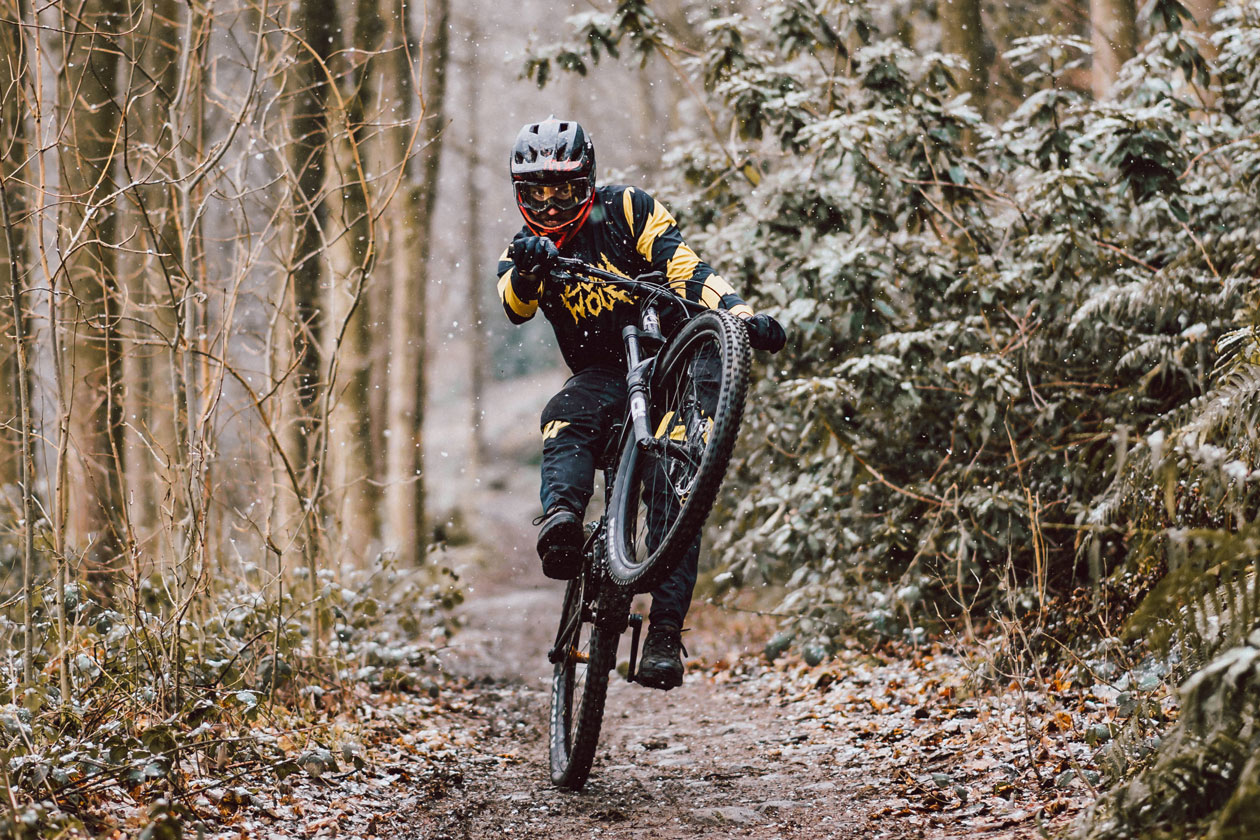
On less demanding terrain, the highly compliant suspension, high weight, and stable geometry does add up to a lot of effort being required to muscle the bike around. With my usual active riding style, some tighter trails became fatiguing and certainly less fun than a more “connected” feeling bike. However, the benefit to the flat out, gnar-taming abilities of the Spur will be enough for some to accept these drawbacks. It helped to run the Storia shock with the LOK lever activated for the most mellow trails, where the rear wheel continued to provide a good level of cushion whilst allowing for more speed to be generated through pumping and popping through the terrain. But make no mistakes, this is not a bike for the “jib” inclined nor for cruising down a flow trail. It takes a high level of gnar to make the Spur come into its own.
Throughout the test, the Effigear box required absolutely no attention. I did not have to play with cable tension throughout the test, whereas I would usually have to make small adjustments every few rides on a conventional gearing setup. From time to time, it would emit a loud “click” when first stepping on the power after a gear shift, but there was no feeling of slipping or skipping when doing so. At times I felt as if there was a slight rattle or vibration coming from the frame and could never pin down the root-cause of this, so I was unsure if it were the gearbox tensioning spring that was to blame. Not a big issue by any means, but a slight nuisance on an otherwise dialed, tight bike. The eccentric dropouts proved to be a delight to use and adjust but did manage to rotate slightly once during the test, releasing a little chain tension that caused the only chain-related issue of the test as it fell off the rear cog. A quick trailside re-setting of the chain tension solved this issue, and with a little extra bolt preload to keep the dropout firmly in place there was not a single other issue for the remainder. My testing period did not require the yearly oil change that the gearbox benefits from, but from what I gather this process is very pain free and intuitive. It is safe to say there is a good bit less maintenance required for the Effigear gearbox setup when compared to a conventional drivetrain, and fewer parts to replace (in addition to a reduced likelihood of damage) mean you will be able to save some money in the long run. At £3000 or so for the frame and gearbox, the Spur is about £1200 more than a non-gearbox equipped Starling frame. This does not seem like terrible value when you factor in the price of a similarly well-performing drivetrain, plus the likely reduction of running costs.
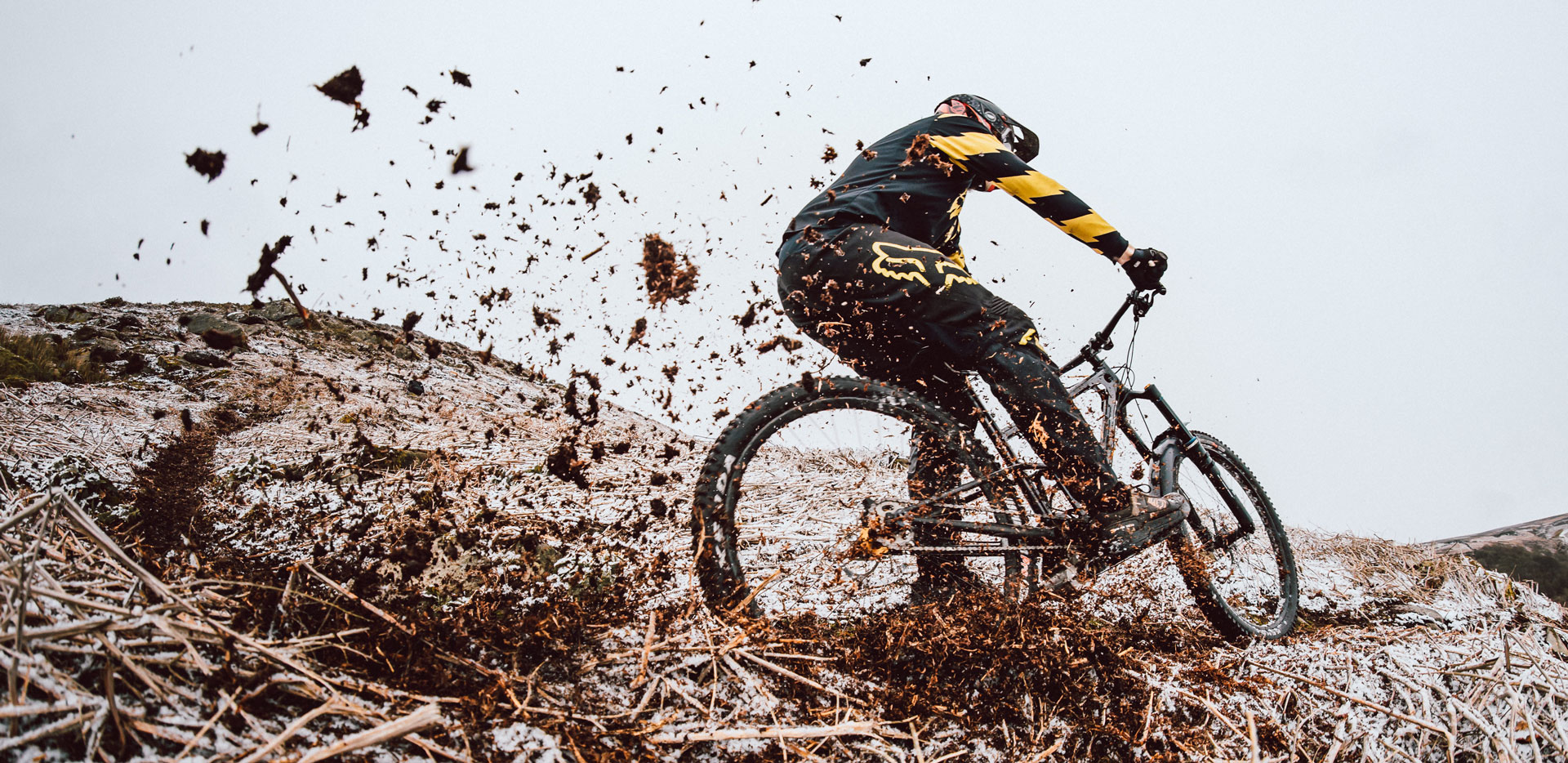
The Wolf’s Last Word
Starling’s Spur gearbox-equipped Enduro bike is a real force to be reckoned with in the correct terrain. The gearbox drivetrain setup will not be for everyone, but for those who find value in its relative simplicity, durability and unique riding traits, there is a great user experience to be had. For riders who tend to spend their time on smooth and easy uphills and downhills, the Spur is not the machine for you, but you probably know that already. But if you give it a healthy dose of climbing over slick and rough terrain followed by a downhill bike-appropriate descent, you will be grinning from ear to ear as your envious riding buddies witness the Spur in action. ![]()
Price: – T.B.D (estimated £3000 with gearbox)
Weight: 40.8lbs/18.5kg (as tested, with pedals)
Website: Starlingcycles.com
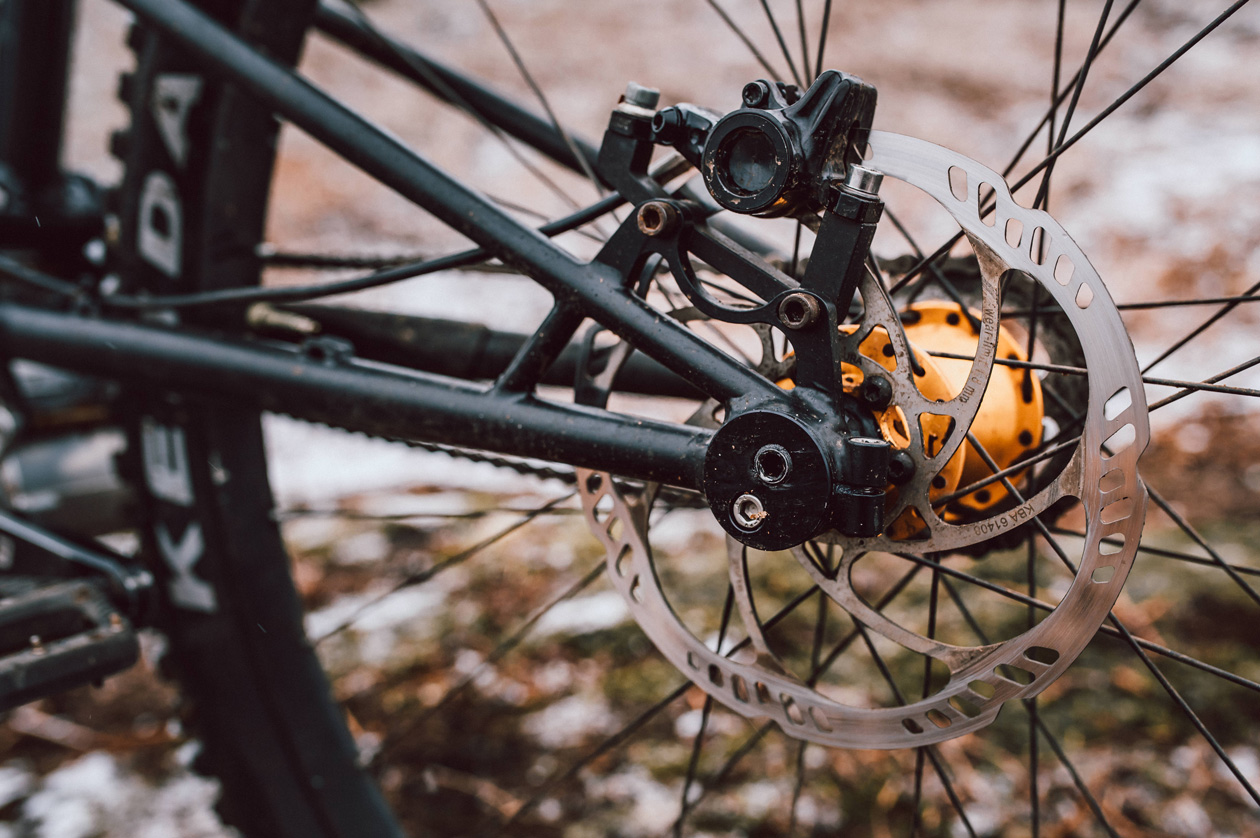
SPECIFICATIONS
CHASSIS
Frame: Steel, Gearbox equipped | 170mm
Fork: Ohlins RXF 36 | 170mm
Shock: EXT Storia LOK V3
COCKPIT
Brakes: Magura MT Trail | 203/180mm
Shifter: Effigear
Handlebar: Funn
Stem: Funn
Saddle: Funn
Seatpost: Bikeyoke Revive
WHEELS
Hubs: Project 321 (r) / Hunt Wheels (f)
Rims: Mavic XM481 (r) / Hunt Endurowide (f)
Front tire: Kenda Hellkat ATC
Rear tire: Kenda Pinner AGC
DRIVETRAIN
Gearbox: Effigear 6-spd Gearbox
Cranks: Effigear | 15t
Cassette: Single-Speed 25t
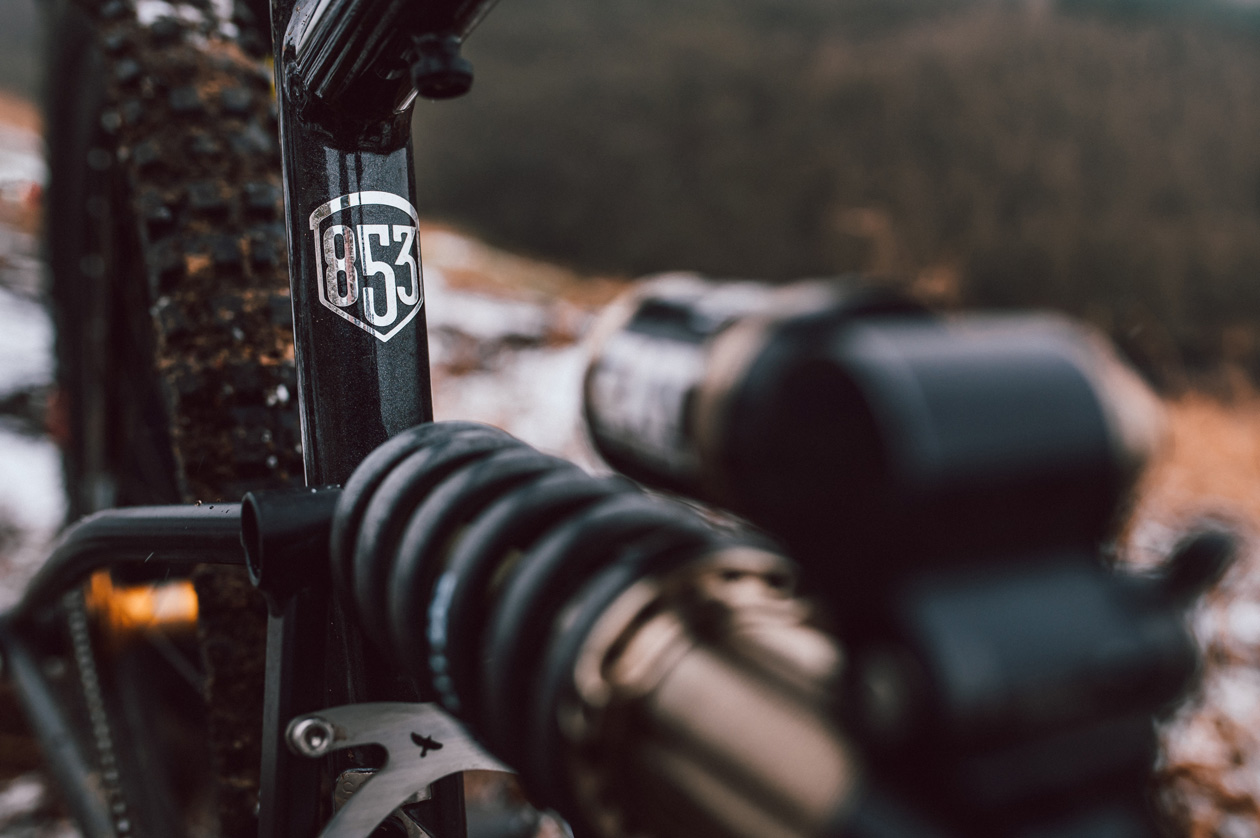
We Dig
Faultless shifting every time
No derailleur to worry about
Reduced maintenance
Suspension excellence
Grip
Silence
We Don’t
Drag on smooth climbs
Overall weight
Mellower terrain performance
6 gears making me feel weak (9spd on production)
LEAVE A COMMENT | WIN FREE STUFF
Want to win some free schwag? Leave a comment and vote up the most thoughtful comments and each month we’ll pick a winner. The person with the smartest and most helpful replies will earn some sweet new gear. Join the Pack and get the latest news and read the latest reviews on the top mountain and electric mountain bikes.
